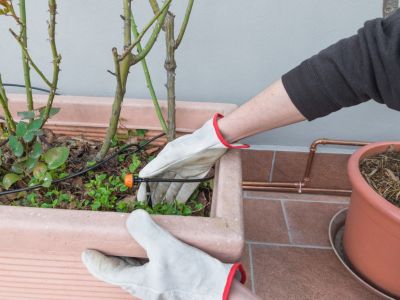Most importantly, whatever container irrigation system you choose, take time to practice and work out any problems before you leave for a vacation or weekend away. The last thing you want is to come home to a bunch of wilted, dead plants. Here are a few tips on container irrigation systems.
Container Drip Irrigation Systems
If you travel frequently or you don’t want to spend a lot of time watering potted plants, you may want to invest in a drip irrigation system. Drip systems are convenient and make good use of water without wasteful runoff. Container drip irrigation systems range from large, complex systems to simple set-ups that take care of a few plants. Of course, more complex systems carry a heftier price tag. Once you decide, experiment with the system until you get it just right, then make adjustments during rainy weather or periods of extreme heat or drought.
DIY Container Irrigation The Old-Fashioned Way
Set an oscillating sprinkler so it sprays one direction only, then experiment until you get the spacing just right. Once everything looks good, attach the hose to a timer and set it to water your plants early in the morning. Avoid watering in the evening, as wet plants are more likely to develop fungal diseases.
Irrigate Container Gardens With Self-Watering Pots
Self-watering pots have built-in reservoirs so plants can draw water when they need it. Good pots aren’t cheap, but most will keep plants watered for two to three weeks, depending on weather conditions and the size of the pot. Self-watering window boxes and hanging baskets are also available.
DIY Container Irrigation With Recycled Bottles
In a pinch, you can always resort to bottle-watering. Drill a hole into the plastic cap or cork. Fill the bottle with water, replace the cap, then invert the bottle into damp potting mix near the base of the plant. Bottle-watering isn’t a good long-term solution, but will help keep the roots from drying out for a few days.
How to Irrigate Container Gardens With Wicking Systems
Wick-watering is an effective, low-tech method that works well if you have a few pots placed close together. Put the pots in a circle and place a bucket or other container between the pots. Fill the bucket with water. For each pot, put one end of a wick in the water and poke the other end deep into the soil. Wick-watering works best with a lightweight potting mix. Add perlite or vermiculite if your potting media tends to be heavier. Water the plants first, and soak the wick in water. The wick will draw more water to the plant as moisture is needed. Shoelaces make good wicks, but synthetic materials last longer and won’t develop mold or fungus. On the other hand, many gardeners prefer cotton for growing tomatoes, herbs, or other edible plants.
